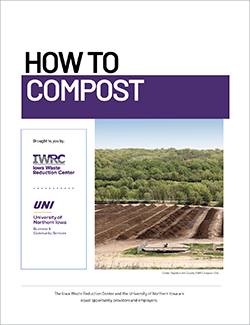How to Compost
There are many benefits to composting organic waste such as food and yard waste, crop residuals, and even cardboard or paper. Creating compost from yard waste, food waste, and other organic waste is a great way to manufacture a valuable product, compost, with a plethora of benefits.
Resources
Training Guides
Magnets
Download and print copies of our original 5x7 magnets
A quick guide to help you get started.
An overview of proven strategies you can implement using compost to prevent water source contamination.
Best Practices at a Glance
Carbon to Nitrogen Ratio
The optimal carbon to nitrogen ratio of feedstocks combined is generally 30:1 but this can vary depending on your type of feedstocks. Carbon is generally considered “browns” while nitrogen is considered “greens”. You can start with roughly 2-4 parts “browns” to 1 part “greens”.
Mixing
Thoroughly mix feedstocks when adding to your pile. Depending on the size of your compost operation, mixing is important to limit odors and anaerobic conditions.
Moisture
Optimal moisture content is 40-60%. Squeezing a handful of compost should result in a few drops of water rather than a stream or water or barely any drips of water.
Air
The reasonable range of free air space is 30-65%. To encourage airflow and aerobic conditions, ensure your carbon feedstock consists of clean wood waste of various sizes from 1” wood chips or twigs to sawdust.
Temperature
An active pile you are adding feedstocks to should maintain a temperature of 135-165° F.
Curing
A curing pile will eventually become mature enough to use. When you stop adding feedstocks to your pile, allow it to sit and cure. The compost will become mature at ambient temperatures in a few weeks to months.
Limiting Odors
Ensure you are following optimal guidelines. If all else fails, 9 times out of 10 odors can be mitigated by adding more carbon or bulking agent of various sizes but especially allowing airflow by mixing in 1” wood chips will help eliminate odors.
For more in-depth information, download our training guide or find a free workshop near you!
This material is based upon work supported under a grant by the Rural Utilities Service, United States Department of Agriculture. Any opinions, findings, and conclusions or recommendations expressed in this material are solely the responsibility of the authors and do not necessarily represent the official views of the Rural Utilities Service.
Rural Community Assistance Partnership, Inc., Iowa Waste Reduction Center, and University of Northern Iowa are equal opportunity providers and employers.





